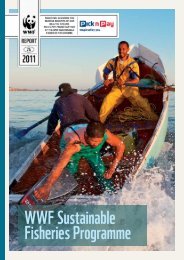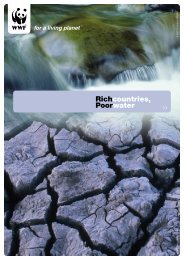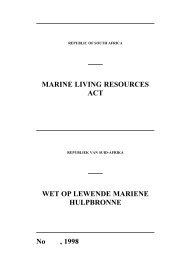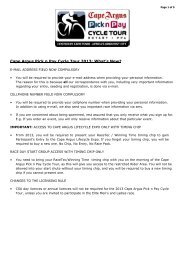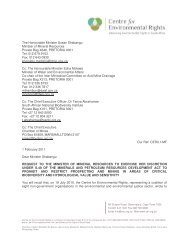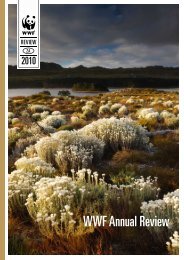State of Management of South Africaââ¬â¢s ... - WWF South Africa
State of Management of South Africaââ¬â¢s ... - WWF South Africa
State of Management of South Africaââ¬â¢s ... - WWF South Africa
- No tags were found...
You also want an ePaper? Increase the reach of your titles
YUMPU automatically turns print PDFs into web optimized ePapers that Google loves.
STATE OF MANAGEMENT OF SOUTH AFRICA’S MARINE PROTECTED AREASThe proposed zones in the Integrated <strong>Management</strong> Plan (IMP) are compatible with theexisting zones regarding the use <strong>of</strong> marine living resources; however different names andtwo additional zone types were introduced in the IMP. This zonation pattern containsdescriptions <strong>of</strong> the inherent characteristics <strong>of</strong> the zones, purposes <strong>of</strong> the zones and listsextensively all the permissible and non-permissible activities. It was indicated that thiszonation pattern was still to be reviewed after comments were received from EKZNWscientific services.<strong>Management</strong> authorities reported that the combined use <strong>of</strong> the NEM:PAA, the WHCA andthe MLRA was effective for management purposes as weaknesses and gaps in the MLRAwere addressed in the other legislation. It was indicated that more clarity regarding theconditions <strong>of</strong> subsistence permits was required as there had been difficulties in enforcingthese.8.4.3 MPA designMPA DESIGN (75%)Most critical habitats were included within the boundaries <strong>of</strong> the MPAs, however because thedeep canyons are located on the <strong>of</strong>fshore boundary <strong>of</strong> the MPAs, it was suggested that theboundaries be extended further <strong>of</strong>fshore so to provide effective protection for these habitats.In addition, the Delgoa bioregion break is located at Cape Vidal and the extension <strong>of</strong> theMPA to include the southern portion <strong>of</strong> the Park, would <strong>of</strong>fer increased protection to a section<strong>of</strong> the Natal bioregion, the transition area between the two bioregions and the estuary. Thesize <strong>of</strong> the MPA was adequate for maintaining ecological processes. Critical areas includedwithin the MPAs were afforded extra protection through the zonation <strong>of</strong> the MPAs under theMLRA.8.4.4 MPA management planEXISTENCE OF PLAN, OBJECTIVES AND REGULATIONS (75%)The iSimangaliso Wetland Park was managed as one integrated system. The iSimangalisoAuthority was required to develop an IMP for the Park. At the time <strong>of</strong> the assessment, an IMPhad been drafted and Conservation Operation Plans for the marine section <strong>of</strong> the Park weredrawn up using the IMP as a guide. The objectives for the Park as a whole differ to thoseunder the MLRA for the MPAs. No site specific objectives for the MPAs were provided in theproclamation under the MLRA, however specific and relevant objectives had been providedin the IMP. The IMP clearly defined the allowable and restricted activities in the differentzones in the MPAs.Pg 133






